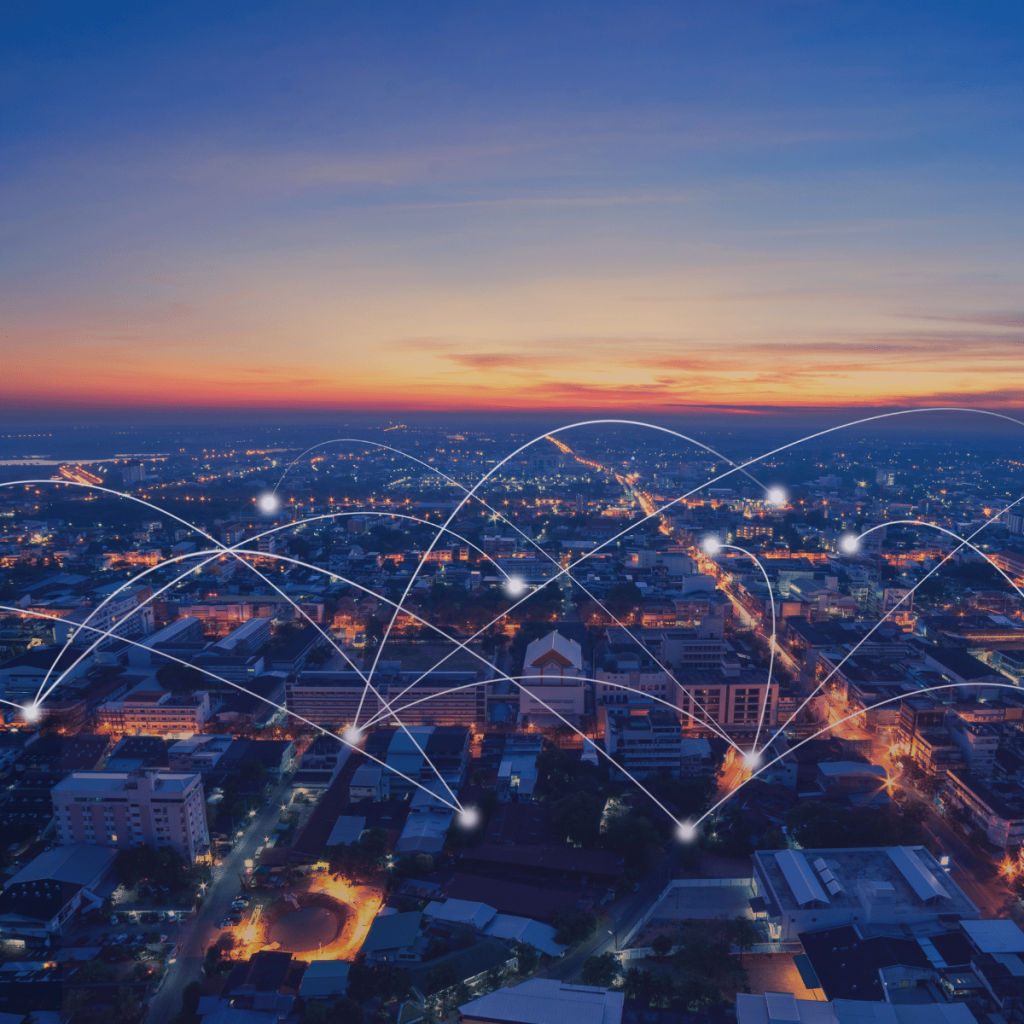Cybersecurity and Smart Cities: Challenges, Privacy, and Solutions
- Cayley Wetzig, Head of Marketing Communications
With the increasing digitization of our world, cybersecurity has become a top priority for individuals and businesses. But cybersecurity is not only something to worry about for your personal computer and big businesses. However, the collision of issues related to cybersecurity and smart cities is becoming increasingly concerning for municipalities worldwide.
A recent report shows that the global market size of smart cities will reach $6,061 billion by 2030. As more city systems go online, they become more vulnerable to cyberattacks that could bring city operations to a halt.

Cybercriminals could potentially disable critical infrastructure like traffic lights and water systems. In addition, there are privacy concerns to consider, as smart city systems collect data on everything from traffic patterns to energy usage.
So, what are some of the challenges in meshing cybersecurity and smart cities? And what are some possible solutions? Let’s take a closer look at the world of cybersecurity and smart cities.
What is a Smart City?
A smart city is an urban area that uses different types of electronic data collection sensors. The sensors supply information that is used to manage assets and resources efficiently.
The information from smart city sensors helps manage city traffic, water supply, waste management, and crime detection. Smart cities use data analytics and artificial intelligence to make better decisions and improve the quality of life for residents.
Although the definition of a smart city varies, the underlying concept is that it has optimized functions. These functions propel economic growth and improve the life quality of its citizens using data analysis and smart technology.
Some of the key characteristics of a smart city include:
- The use of green technology and sustainable practices to reduce the city’s carbon footprint
- Well-thought urban planning
- A highly functional system of public transport
- Technology-based infrastructure
- Ability to provide services and opportunities for all residents, regardless of social status
Statistics show that 68% of the world’s population will live in urban areas by 2050. This increase in population density means that cities must find ways to become more efficient and livable. Smart city technology is one way to do this.
Cybersecurity and Smart Cities: Considerations
Cybersecurity is vital for any type of city, but it is especially critical for smart cities. This is because smart cities rely on a high level of connectivity to function properly. There are several cybersecurity aspects that municipalities need to consider.
City leaders should consider that critical infrastructure in smart cities faces the threat of sophisticated attacks. For example, a cybercriminal could target the traffic management system of a city and cause widespread gridlock. This type of attack could have severe repercussions for public safety.

There’s the risk that cybercriminals could abuse low-power wide area networks (LPWANs) and hijack communication between devices. LPWANs are used to connect devices over long distances, using very little power. They are often used in smart city applications, such as water and waste management.
Cybersecurity experts have found that it is possible to exploit vulnerabilities in LPWANs to gain access to a city’s network. Once cybercriminals have access to the network, they could cause havoc by disabling critical systems.
In smart cities, cybercriminals can manipulate sensor data and cause panic among residents. For instance, they could make it appear like there is a chemical spill in the city when there isn’t one. This type of incident could cause widespread panic and chaos.
Cybersecurity and Smart Cities: Privacy Concerns
Cybersecurity concerns are rising as smart cities become more prevalent. One of the main issues facing smart city planners is how to keep citizens’ data safe and secure. With so much information being collected and stored in databases, there is a greater risk of data breaches and cyberattacks.
If cybercriminals were to gain access to these databases, they could glean sensitive information about individuals, such as personally identifiable information (PII), financial data, and health records. This could lead to various problems, including identity theft, financial fraud, and physical harm.

Another privacy concern relates to the use of surveillance cameras. While these cameras can help to improve public safety, they also raise questions about how much information is being collected and who has access to it. There are also concerns about how this data may be used in the future.
Cybersecurity and Privacy Solutions in Smart Cities
There are several steps that city leaders can take to mitigate the cybersecurity and privacy concerns associated with smart cities. One of the essential things cities can do is create a comprehensive cybersecurity strategy. This strategy should address the cybersecurity risks associated with smart city applications and systems.
Cities should also consider implementing privacy-enhancing technologies (PETs). PETs are designed to protect individuals’ privacy while still allowing data to be collected and used for legitimate purposes. One example of a PET is data anonymization, a process of transforming data so that it can no longer be linked to a specific individual.
Another solution is to encrypt sensitive data. Encryption ensures that, even if data is compromised, it will be difficult for cybercriminals to use it. City leaders should also consider implementing access control measures, such as requiring individuals to authenticate themselves before accessing certain data.
Finally, cities should develop policies and procedures for handling data breaches and cybersecurity incidents. These policies should outline the steps to be taken in case of a breach or incident. They should also include procedures for notifying individuals whose data has been compromised.
How Smart City Planning Could Slow Future Pandemics
The COVID-19 pandemic is a wake-up call for cities around the world. It’s a reminder that we need to be prepared for future pandemics. And that’s where smart city planning comes in.
There are several ways that smart city planning could help to slow the spread of future pandemics. One is using data and analytics to track the spread of disease. City officials can then use this information to identify hot spots and take steps to contain the outbreak.
City leaders can also use smart city technology to improve communication between different agencies and organizations. Communication could help to coordinate efforts to contain the spread of a pandemic.

Another way that smart city planning can help is by increasing transparency. This could involve sharing data about the spread of disease with the public. Transparency would allow people to make informed decisions about their own health and safety.
Smart city planning can help to slow the spread of pandemics by using contact tracing. This involves using data from smart city applications and systems to identify individuals who have come into contact with someone who has contracted a disease. These individuals can then be notified and told to self-isolate to prevent the disease from spreading further.
Other Smart City Challenges
In addition to cybersecurity and privacy concerns, there are several other challenges associated with smart cities. These include:
Insufficient Infrastructure:
Smart cities require physical and IT infrastructure to support their operations. This includes things like sensors, data storage, and computing power. Unfortunately, many cities do not have the infrastructure to support a smart city, making it challenging to implement smart city applications and systems.
Lack of Effective Data Processing and Analytics:
A crucial part of a smart city is the ability to collect and process data. City officials can then analyze the data to make better decisions. Unfortunately, many cities cannot effectively process and analyze data, so they can’t fully take advantage of the benefits of a smart city.
Political Differences:
Smart cities are directly related to political cycles in cities. If the political capital expires before a project’s completion, the incoming administration will scrutinize the ongoing smart city initiative, leading to operational complexity and delays. This could result in a loss of interest in the project and a decrease in funding.
Lack of Standards:
There are no global standards for smart city applications and systems. This makes it difficult for cities to interoperate with one another. It also makes it difficult for vendors to develop products that work across different city environments.
Cybersecurity and Smart Cities: Solutions
While smart cities present several challenges, there are also potential solutions. These include:
Proactive Thinking About Security Risks:
City planners need to look at security risks from the ground up to ensure that smart cities are founded on security and incorporate safety measures at every step of developing the city. In other words, they should ensure that the design of the city’s infrastructure is secure. Proactive thinking will minimize vulnerabilities once the smart city goes into full swing.
Brainstorm How to Reduce Privacy Concerns:
Smart city planners should work with cybersecurity experts to identify ways to reduce privacy concerns. Additionally, they should develop policies and procedures to ensure that data collected by smart city devices is used ethically and responsibly.
Ensure Interoperability:
One way to overcome the lack of standards for smart city applications and systems is to ensure interoperability. This involves using standard protocols and developing open-source solutions. Additionally, cities should work together to develop standards that all smart city applications and systems can use.
Smart cities are becoming a reality as the world becomes increasingly urbanized and more connected. While the cities offer many benefits, they also present several challenges, particularly in the cybersecurity and privacy arenas. However, city planners and officials can overcome these challenges by cooperating proactively to create more secure and efficient cities.
Protect Your Organization from Phishing
Explore More Resources
- Article, News
- Article, News
- Article, News
- Article, Blog
Your Trusted Source for Cyber Education
Sign up for ThriveDX's quarterly newsletter to receive information on the latest cybersecurity trends, expert takes, security news, and free resources.

